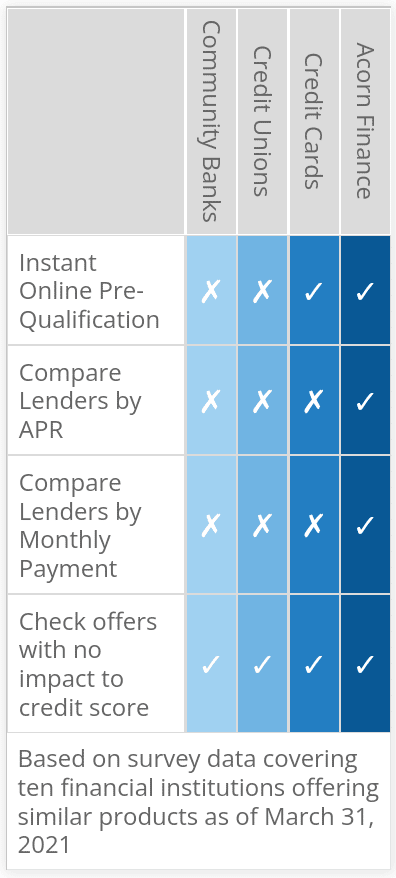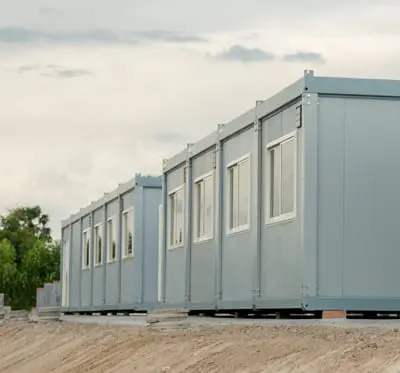Home Addition Financing
Get personalized rates in 60 seconds to start financing a home addition with no impact to your credit.
How much would you like to finance?

Financing For Home Additions
Select the perfect personalized home addition loan, just for you. Whether you are looking to do a complete home remodel, or just need to finance some new furniture, Acorn Finance has you covered.
No matter your credit score, if you want to secure home addition financing, Acorn Finance will get you pre-qualified loans in seconds to add to your home. Easily sort all the loan offers by what matters to you: interest rate, payment amount, length of the loan term.
Never impact your credit score when comparing rates between our network of trusted partners. 100% online, customer-friendly process is designed to help you find affordable payment options with lenders that can quickly fund your home addition plans.
Home Addition Loans With Acorn Finance

Pre-qualify

Select offer

Finish application

Receive funding
How To Get A Home Addition Loan
Check offers
in seconds
Won't impact
credit scores
Competitive
payment options
Receive
funds quickly
Compare Rates From Lenders in Our Network
Best Home Addition Financing Options
Adding a room can deliver an average ROI of over 50%, making a home addition loan easy to justify. So how do you go about financing a home addition? Acorn Finance offers a user friendly secure platform that allows you to receive multiple personalized competitive offers by submitting just one application. In addition, your credit will not be affected by submitting the application. Visiting Acorn Finance is the start of a very wise investment, a home addition loan! Keep reading to learn more about home addition loans.
Read More
Can you get home addition financing?
Yes, you can get a loan for a home addition. Personal loans are available for all types of credit and can be used for home addition financing. Although rates may be higher compared to secured loans, most personal loans don't require any collateral. Personal loans are often easier to secure and tend to be less risky than comparable options.
What is the best way to start financing a home addition?
Personal loans are a leading option for home addition financing. In addition to being less risky and requiring no collateral, personal loans offer many pros. Comparing lenders is important if you decide to use a personal loan. Most likely, many lenders will be competing to secure your loan. This means you have the ability to shop rates and terms and make sure you get the best deal. Acorn Finance is a secure platform that makes receiving competitive offers from multiple lenders easy.
Let's take a look at the pros and cons of a personal loan for home addition financing.
PROS
- Simple application and approval process
- No collateral needed
- Fixed interest rate for the duration of the loan (in most cases)
- Competitive interest rates
- Borrow almost any amount (typically between $1,500 – $100,000)
- Generous amount of time allowed to repay loan
- Quick funding
CONS
- Interest rates may be slightly higher than comparable options
- Credit history necessary in most cases
- Fixed payments
- Many personal loans have origination fees
- Some personal loans come with prepayment penalties
How much does it cost to add an addition to your house?
Building a room or home addition costs an average of $44,805. Reports show that most homeowners spend between $21,003 and $68,606. There are many factors such as materials, location and type of addition that can vary the cost of your job.
How much does a standard 20'20 room addition cost?
On average it costs around $48,000 to add a 20'20 family room. Home addition financing can provide an affordable solution that can help increase the value of your home. Most likely you can recoup interest expenses associated with the loan when you sell your home.
How much does it cost to add a bedroom and bathroom to a house?
Adding a bathroom or bedroom can be significantly cheaper than adding a 20'20 room. On average, it costs about $17,300 to add a 12'12 bedroom. Adding a bathroom typically starts around $18,000.
How much value does an extra bedroom add to your home?
In most cases, adding a bedroom to your home will increase the value and desirability. Every property should be evaluated on an individual basis by a professional to determine the exact value. You can use an increase in value between $30,000-$50,000 per room as a ballpark estimate.
Is it cheaper to build out or up?
Typically it's cheaper to build up rather than out, but there are some cases where this is not true. Regardless of which way you build homeowners pay an average of about $80 to $200 per square foot for home additions.
Can you live in a house while adding a second story?
In most cases, yes you can live in a home while adding a second story. The contractor can isolate certain parts of the home to provide you and your family safe living spaces.
Is home addition financing worth it?
Home additions are usually a very wise investment. It's important to make good decisions and make sure your project is economically friendly yet done properly. Setting budgets before starting your home addition can help you achieve a higher ROI.
How can I add a cheap room to my house?
An extra room can expand your living space, but it comes at a cost. In some cases, you may not be able to or willing to afford the cost of adding a room to your house. The good news is that there are cost-effective ways to add a cheap or cheaper room to your house. As a homeowner, this is your space. You may want to combine a few different ideas to create the perfect room that fits your budget.
Even if you take cost saving measures to add a room, you may still need to use financing. Keep in mind that adding a room can increase your home value. While you may be on a tight budget, you should ensure things are done properly. If you ever decide to sell your home you will want potential home buyers to be turned on by the extra room, not turned off because it was not built or executed properly.
Here are some ways to add a cheap room to your house:
Finish the basement: If you have a basement or attic, you may be able to convert it into livable space. Since you won't need to build a foundation or worry about structural elements, converting a basement or attic can be a cheap way to add more livable space to your home.
Bump out existing living space: if you just need to add a small bedroom, you may be able to add extra space to an existing room. Bump out additions are generally used for smaller spaces and can be a cost effective way to add a room to your house.
Build a sunroom: For some, the idea of a sunroom is exciting. What a cool way to add a bedroom to your home. Sunrooms can provide homeowners with a versatile yet inexpensive living space. Since they are made of windows or glass doors, they are usually cheaper than a room with solid walls or insulation.
DIY: So it may sound like a big task to add a bedroom to your home by yourself, but it can be done. The Internet can provide tons of useful information and advice that can help you create an extra bedroom DIY style.
How much does a typical home addition cost?
The cost for a home addition can depend on several factors. However, if we are looking at averages that combine all the variables, we are looking at about $48,000 to add a room or home addition. The low end of the average is around $22,500 and the high end of the average is around $74,000. Increasing the square footage of your home can increase your home value and offer a good ROI. The type of home addition you add can also impact the cost. For example, it's usually cheaper to add a bedroom than it is a bathroom. A bathroom may require appliances and plumbing, thus increasing the cost.
How much should I spend on a home addition?
There really is no set amount that you should or should not spend on your home addition. In addition, some projects may be more complex than others, making it difficult to compare your project to someone else's. However, what you can do is gather several estimates to determine a fair price for your home addition. If you are trying to adhere to a certain budget, you should communicate the budget with the contractor. The materials and design elements you choose can significantly impact the cost. If the contractor knows your honest budget, they can make more appropriate recommendations. To give you some kind of ballpark, let's take a look at some home addition averages:
The average cost of adding a kitchen is around $34,000.
The average cost of adding a room is around $17,000.
The average cost of adding a family room is around $59,000.
The average cost of adding a sunroom is around $19,000.
If you plan on using financing for a home addition, there may be additional costs associated. You should consider the total loan cost to determine if the home addition is worth it or not. If you need a home addition for your family to stay once or twice a year, you may end up deciding it's easier to put them up at a hotel rather than building a home addition. However, if you plan to build a home addition so that you can have an official workspace, it may easily be worth it. In addition, if you are building a home addition to serve as an office or business related space it may be tax deductible.
What is the most expensive part of a home addition?
If you are building a home addition, you can expect a large portion of your budget to go toward the framing. The type of framing can impact the cost so keep that in mind as you make decisions. Stick framing is typically the least expensive type of framing. In addition, it's very common. The larger the home addition, the more you can expect to spend on framing.
Can you get a home improvement loan right after buying a house?
After buying a house may not be the best time to take out a home improvement loan. However, you may have no other choice. It is possible to qualify for a home improvement loan after buying a house. Before you apply you will want to make sure that your home loan has been recorded and funded. If you are buying a home that needs known repairs, such as a fixer-upper, you may want to consider an FHA 203(k) loan. An FHA 203(k) loan can allow you to combine your mortgage with the renovation costs. This may offer you a lower interest rate compared to a home improvement loan. In addition, it will probably be easier to manage one monthly payment as opposed to two.
How soon after closing can I apply for a HELOC?
To qualify for a HELOC, you will need equity in your home. to be specific, you'll probably need 20% equity in your home to qualify. If you just purchased your home, you may not have this much equity yet, unless you put down a substantial down payment. While there is no specific waiting period for getting a HELOC after buying your home, you will need to make sure you qualify before you apply. Otherwise, you will just be wasting your time and the lender's time. If you are unsure if you qualify or not you should consult a professional before applying.
If you do qualify for a HELOC shortly after closing escrow, you may not need a new home appraisal. This may save you some time and money during the application process for a HELOC. A HELOC is a revolving line of credit that is secured by the equity in your home.
How can I save money on my house addition?
From start to finish, there are many ways to save money on your home addition. In the beginning it's important to shop lenders and contractors to secure the best terms and pricing. Here are a few other ways to save money on your home addition:
- Avoid overdoing it
- Take tax credits and refunds into consideration
- Be flexible with your plans
- Shop for discounts or discount warehouses
- Negotiate items that can be done yourself
What type of loan is best for a home addition?
There are a variety of loans for home additions providing homeowners with plenty of options. So what type of loan is best for a home addition? Your finances and goals will most likely determine which type of loan is best for you. If you need to borrow $100,000 or more, you may be limited to secured loan options. Secured loans typically offer lower interest rates, longer terms, and higher loan amounts compared to unsecured loans. However, secured loans may be harder to secure and involve more risk for the homeowner. Secured loans such as a home equity loan require homeowners to use their home as collateral.
How much can I borrow for a home addition?
Loan amounts for home addition financing can vary depending on a variety of factors. These factors can include the borrower's credit score and history, the type of loan, lender requirements, and more. Acorn Finance has lending partners that can provide unsecured loans for home addition financing up to $100,000. Some lenders may disclose online or via phone what their maximum loan amounts are for different loan products. If you have a lender of choice you may want to see if they can accommodate the amount you need to borrow. Keep in mind that you will have to qualify for the loan amount. Just because lenders advertise certain rates, loan amounts, and terms it does not mean that you are guaranteed to qualify.
How much does it cost to add 300 square feet to a house?
According to Home Guide, a 300 square foot home addition costs an average of $25,800 to $62,400. You will notice that the average cost can vary significantly. When it comes to home improvements or home additions, each project has its own set of unique needs. Project requirements, materials, location, and more can impact the cost of a home addition. The type of home addition can also impact the cost. For example, a bedroom addition is usually cheaper than a bathroom addition. Bathrooms usually require plumbing, fixtures, equipment, and so on. These items should be factored into the project costs. If you are trying to estimate project costs for a home addition you should consider the following costs:
site work
foundation
framing
exterior finishes
major systems
interior finishes
final steps
How much does it cost to build a 500 sq ft addition?
In most cases, the price difference between a 300 sq ft addition and a 500 sq ft addition is significant. According to Home Guide, a 500 sq ft home addition costs an average of $43,000 to $104,000. Estimating the exact cost of a home addition can be challenging. Unexpected obstacles and challenges are relatively common in the building world. As you start to estimate home addition costs you should consider a best case scenario and a worst case scenario in terms of money. Planning for the worst case scenario may put you ahead in the end. If you are using a loan for home addition financing you may need to borrow more than you think you need. If you do not use all the funds, you can repay the unused portion to reduce your balance and hopefully save on interest charges.
How can I finance a home addition without equity?
If you do not have equity in your home you can still finance a home addition. Most homeowners that do not have equity use unsecured personal loans for home addition financing. While you may be able to use a credit card or payday loan for some of the project costs, these types of loan typically do not provide enough money. Unsecured personal loans may have higher interest rates than secured loans but can still be a very competitive option. Acorn Finance has top-rated lending partners that specialize in home improvement and home addition financing. Homeowners can submit an application at Acorn Finance and check offers within seconds without affecting credit score.
How do I know if I can get a home equity loan?
At the minimum homeowners should have fair credit and at least 20% equity in their home to qualify for a home equity loan. Even though you are providing collateral most lenders will still assess debt-to-income ratio, credit history, ability to repay the loan, and so forth. Most lenders allow homeowners to borrow up to 80% of the home's value. Lenders can have different requirements for qualifying. Most lenders can share basic requirements to help potential borrowers determine if they should apply or not. If you are considering a home equity loan you should check with your primary financial institution.
How much equity do you need for a home equity loan?
In most cases, homeowners need to have at least 20% equity to qualify for a home equity loan. The more equity you have, the more you can potentially borrow. For example, let's say your home is worth $400,000 and you owe $200,000. In this scenario the homeowners have 50% equity. If they are using a lender that allows a combined loan-to-value ratio of 80%, the homeowner should be able to borrow $120,000, thus increasing the amount owed on the home to $320,000. To estimate how much you can borrow based on the equity you have, you can use an online home equity loan calculator.
Can you add renovation costs to the mortgage?
Renovation costs can technically be added to the mortgage if you use a home equity loan. When you use a home equity loan you are borrowing against the equity in your home, thus increasing the amount you owe on the mortgage. If you have a home equity loan and want to sell your home, you'll need to satisfy the home equity loan and your mortgage in order to properly transfer ownership of the home. You can compare this to selling a car that you owe money on. The lender will not release the title until the vehicle is paid off. Car loans are secured loans, similar to home equity loans.
Can you get a mortgage for an addition?
A traditional mortgage cannot be used for a home addition. However, you may be able to refinance your mortgage or cash out refinance to pay for a home addition. If interest rates have dropped significantly since securing your current mortgage, this option may make sense. A cash out refinance is similar to a home equity loan in some ways. Most lenders allow homeowners to refinance up to 80% of the current value of their home using a cash out refinance. In most cases, a home equity loan is a better option but it all depends on the homeowners and their finances. In our current market we saw interest rates hit an all time low. As a result many homeowners took advantage of refinancing options.
Can you use a home improvement loan for anything?
In some cases, you can use a home improvement loan for anything. Whether you can or can't usually depends on the type of loan and the lender's guidelines. While most lenders will ask you upfront why you need to borrow the money, they may not monitor how you spend the money. For example, if you use an unsecured personal loan for home improvements the lender should issue the funds as a lump sum. Most of Acorn Finance's lending partners do not have spending restrictions, thus allowing borrowers to spend funds on just about anything they need or want.
How do you finance a home addition easily online?
Comparing home addition financing offers can be time consuming. In addition, you may damage your credit if several lenders are authorized to pull your credit. One of the easiest ways to access home addition financing offers online is at Acorn Finance. Checking offers at Acorn Finance will not impact your credit score. Once you have compared offers, you can take advantage of the offer of your choice. Acorn Finance lending partners can offer easy monthly payment options and funding in 1-2 days.
Can you add remodel costs to a mortgage?
In some cases, you can add remodel costs to an existing mortgage, if the lender allows the expenditure. Not all types of mortgages will allow this and you need to double check with your specific mortgage provider to see if this is something that they allow. They may also need to know about the renovations that you plan to do on the home before they approve the request. There are several different programs that can be utilized to finance a home remodel with an existing mortgage.
In most cases, it's easier to finance the remodel with the mortgage at the time you purchase the home. In fact, there are specialized loan programs designed to help you do this. FHA loans or Fannie Mae loans can allow you to purchase a home and remodel it all with one loan. The FHA and Federal National Mortgage Association are government agencies that can sponsor rehabilitation mortgage programs, thus allowing homeowners to remodel their home with one mortgage.
How do people afford additions?
Although it's a bad habit, sometimes we find ourselves comparing our life to someone elses. Maybe your neighbor just remodeled their kitchen and invited you over for a tour. You left thinking, wow, I want a kitchen like that. How the heck did they afford that? While they may have saved up enough cash, it's likely that they used financing. If you have equity in your home, you may be able to use a secured loan. Secured loans may offer lower interest rates but require you to borrow against the equity in your home. Qualifying for a secured loan can be more difficult than qualifying for a home improvement loan. A home improvement loan is often just a personal loan that is used for home improvements. Let's take a look at a few ways you can finance home additions or remodels:
Get a home equity loan: Home equity loans are often referred to as a second mortgage. If you have equity in your home you can leverage it to borrow money. Similar to a home improvement loan, a home equity loan is disbursed in a lump sum and repaid in monthly installments. For large or expensive home additions, a home equity loan may be a smart option, if you qualify.
Cash out refinance: If your home is worth more than you owe on it, you may be able to use a cash out refinance. Furthermore, if interest rates have dropped significantly since you bought your home, a cash out refinance might make sense. Essentially a cash out refinance allows you to take out a new loan on your home for more than you owe on your home.
Get a home improvement loan: Many homeowners decide to get a home improvement loan to help with an addition. This will allow them a way to get the funds without having to dip into the equity of their home. Home improvement loans are usually the easiest type of loan to qualify for.
Choosing the right method to help you pay for an addition is important. It may depend on your own personal finances or which option seems like the right one for you.
How can I remodel my house with no money?
When it comes to some of the bigger home improvement projects that you want to get done, it is easy to feel like you do not have the finances necessary to get the work done. These can get expensive and you may give up all hope of having a home that you love or some of the updates that you have been looking for.
Just because some of the bigger updates are out of reach, does not mean that there is no hope for you to remodel some of your home. Doing a few small things around the home, such as a deep clean, rearranging some of the items that you have in the home, and even adding a fresh coat of paint can do wonders. For such simple projects, they can help refresh your home for little to no money.
If you are comfortable taking out a small loan for home improvement projects, you can do so without any money down. Home improvement loans can be secured with no collateral and no money down. Taking out a small loan can help you expand your budget. If you are able to do some of the improvements yourself, you can use the home improvement loan to finance materials. When it comes to home improvements you should make sure things are done the right way.
How do you finance an addition without equity?
While a secured loan may sound like a great option, you will not qualify if you do not have equity in your home. Luckily, there are ways to finance a home addition without equity in your home. One of the best options is a home improvement loan. There are several reasons you might not have equity in your home. Perhaps you just purchased the home or your home prices have recently gone down. Perhaps you are looking to purchase a home but need to build an addition before moving in. In some cases you may be able to finance a home addition and the cost of the home with one mortgage.
You will want to explore all options that are available to you as situations can vary. Regardless of the situation, most homeowners can qualify for a home improvement loan. Home equity loans can be secured with no collateral and no money down. In addition, some lenders offer home improvement loans up to $100,000. Sounds great, right? So what's the catch? Truth is, there really is none. You might pay a higher interest rate than a secured loan, but interest rates are still pretty competitive. You can also enjoy no spending restrictions. If you want to build an addition and purchase furniture or appliances, you can use one personal loan.
At Acorn Finance our lending partners specialize in home improvement loans. Within 60 seconds or less you can check home improvement loan offers with no impact on your credit score. To top it all off, our lending partners can offer APRs as low as 6.99%, depending on credit score.
What are common home additions?
There are many reasons someone would need to put an addition on their home. Sometimes families can grow beyond what a house is capable of providing. There is always the option of moving, but if you are someone who loves their home, the neighborhood, and the schools, moving just may not be something that you want to do. This is when putting an addition on your home may be in your best interest. You may simply want to expand the living space, or maybe you need to create bedrooms for more children or potential guests. Since many people have been working from home, maybe a home office is in order? However you would like to use the additional space in your home, it can be daunting to perceive the process of making that addition possible. It might be comforting to know that many families across the country are choosing to build an addition rather than move into a new home. Here are some of the most common home additions that homeowners have found successfully added the space that their family needed.
- Basement renovation: If your home has an unfinished basement, then a basement renovation has the potential to create extra bedrooms, bathroom, and a living area. Many people decide to put a rec area in the basement that can be used as a family theater room, game room, or a place to entertain guests with a full bar and additional seating.
- Bathroom addition(s): Having a larger family means that mornings can be pretty busy and everyone needs to get ready in some capacity in the morning hours. An extra bathroom and shower can alleviate some of the morning congestion as kids prepare for school and you prepare for work.
- Sunroom addition: A sunroom is a wonderful addition to a home that can provide additional living space, and at the same time, make you feel more connected to the outdoors with plenty of glass and warm sunshine.
- Mother in-law's addition:As families age, there may come the time where you may have to decide that it may be more economical and good for the overall well-being of your family to have your in-laws close to home. They can help with the kids and you can help in some capacity to care for your elderly parents. A mother in-law's addition creates an additional living space that can include its own small kitchen, bedroom, and private bathroom.
- Office space addition:Working from home can be chaotic if you do not have a quiet space to retreat to when you need to escape the commotion of the rest of the household for a conference call or to simply be free of distractions. Having a closed-off office space is ideal for keeping your work life separate from your family life. Office additions have become more common in the past year due to more employers allowing their employees to work from home rather than to commute to the office.
These are just a few of the most popular types of additions that homeowners in the United States are completing in recent years. An addition is simply creating more space for you and your family to live more comfortably. You may want to consider consulting a general contractor who can walk through your home and help you explore some different options for how you can easily create that much needed additional space.
Is it cheaper to add on or build up?
Overall, it is cheaper to add on to build up. The average cost per square foot for adding on is somewhere between $140 and $180. The average cost per square foot for building up is closer to $180 to $250. The main reason for the price difference is that when you decide to build up, you have to remove part of the roof of the first floor and construct many additional support structures. You also need to build a staircase, install new plumbing and HVAC, and then once the construction is complete on the second floor, you have to complete extensive repairs to the first floor.
Is it cheaper to finish a basement or add an addition?
Generally, it is cheaper to finish a basement rather than to add an addition. An addition requires framing, plumbing, HVAC, electrical, and other infrastructure that can bring the price far above what you would pay to finish a basement that already contains most of the needed infrastructure. Basements may need to be outfitted with egress windows and possibly be weatherproofed. However, most likely the other infrastructure such as HVAC, electrical, and plumbing, are going to be readily accessible for the basement renovation.
What is the cheapest way to add square footage to a house?
One of the cheapest ways to add square footage to your house is to finish an unfinished space. Finishing an attic, basement, or attached garage can be much less expensive than building an addition from scratch. Again, this is because most of the infrastructure needed, lights, water, heating and cooling, most likely will already be in place.
Can you build an addition without a foundation?
Sure, you can build an addition without a foundation. It is called, "bumping out". A bump-out creates additional living space that hangs off the side of the house. The only limitation is the size. A bump-out addition can be no deeper than 3-feet from the house, however, it can be 10 to 12-feet long. Another way to create an addition without foundation work is to create a four-season porch.
How much does it cost to add 1000 square feet to a house?
The average home addition can cost anywhere from $80 to $200 per square foot to complete. That would mean that to add 1,000 square feet to your home, you would be looking at anywhere from $80,000 to $200,000 in total costs including materials and labor. If you are looking to add 1,000 square feet to your home, you may need to consider taking out a second mortgage, a home equity loan or seeking a personal loan. Depending on the total cost of building the addition, you may be able to fund the entire project without using your home as collateral by taking out a personal loan.
Is adding square footage worth it?
There are many factors that determine whether or not adding square footage is worth it. If you are strictly looking at the numbers and you are hoping for the highest return on your investment, then you may want to consider what kinds of additions would make the most sense. You can add square footage by simply finishing a basement. This would be highly cost-effective and may give you the best chance to see a higher return on your investment than building an addition. If you are looking at expanding your family but do not want to move, then adding square footage may be worth it to give you that much-needed additional space without uprooting your family.
Check Offers for Home Addition Financing Today
In conclusion, home addition loans can be justifiable and easy to secure. Home additions can also increase the value of your home. Acorn Finance is a reliable and top-rated company that provides personal loans for home addition financing. Take advantage of affordable payment options and free services while saving tons of time.
Three steps to get started with Acorn Finance:
- Complete and submit a short loan application online
- Receive multiple pre-qualified offers
- Get connected with lenders to obtain your pre-qualified loan
Ready to start shopping for home addition financing? Get started today with Acorn Finance!
How Does Acorn Finance Compare?
Compare Rates From Top Lenders








Home Addition Financing Calculator
Are You A Contractor?
Don’t let home addition financing deals slip away.
Get home addition financing options with easy, affordable payment plans for your customers
Get StartedPopular Home Improvement Projects
Barn Financing Options
One home, endless possibilities




